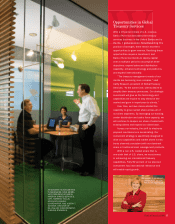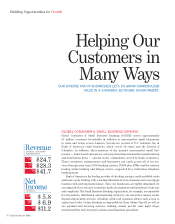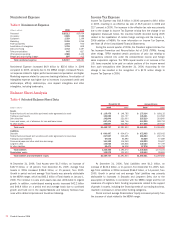Bank of America 2006 Annual Report Download - page 31
Download and view the complete annual report
Please find page 31 of the 2006 Bank of America annual report below. You can navigate through the pages in the report by either clicking on the pages listed below, or by using the keyword search tool below to find specific information within the annual report.
When it opens in the fall of 2007, Renaissance Walk will mark the latest
step in the rejuvenation of Atlanta’s Sweet Auburn historic district. Bank of
America has worked with this community since the early 1990s, initially
investing more than $20 million and using its direct development capabilities
to build 125 residential units — a catalyst for the rebirth of the neighborhood.
Designated a National Historic Landmark in 1976, Auburn Avenue
is home to the Martin Luther King Jr. historic site and birthplace. The
area was dubbed Sweet Auburn because it was one of the few places that
provided opportunities to blacks. African-Americans concentrated many
new businesses, social organizations and churches in Sweet Auburn, con-
tributing to Atlanta’s rise as a major metropolitan center of the New South.
Eventually, the area fell victim to urban sprawl and a cycle of aban-
donment. Yet Atlanta demanded urban living in a revitalized downtown.
Another recent effort was the 2004 Dynamic Metals Lofts project, created
with the Historic District Development Corporation. With $9.3 million in
investment and financing from Bank of America, and its direct development
services, the project built 48 residential units and retail condominiums in
the district. The award-winning project was also the first environmental
cleanup done under Georgia’s new Brownfields law.
The $48 million Renaissance Walk development will create 159 resi-
dential and retail units, secure parking and an Interpretive Center for the
history of Sweet Auburn and Atlanta’s African-American community. Bank
of America provided $34 million in financing through its client The Integral
Group, which leads a financial syndicate and public-private partnership.
The bank’s Neighborhood Excellence Initiative also gave a $200,000
grant to Samaritan House of Atlanta Inc., which helps the district’s
homeless. Philanthropy, sponsorships and Team Bank of America volunteer
programs round out the bank’s commitment to Sweet Auburn and the
communities the bank serves around the country.
Bank of America 2006 29
■ Operate the fi rst, largest and most productive bank-owned
community-development corporation in the nation
■ Committed $400 million in Program Related Investments locally to
create affordable housing, small businesses and jobs
■ Invested $48 million in 44 markets through the Neighborhood
Excellence Initiative during the past three years
Our
Innovations
■ Lend and invest $750 billion in community development over 10 years
■ Devote $1.5 billion to philanthropy over 10 years
■ Provide $200 million in grants during 2007 to build healthy neighborhoods
Our
Commitment ANNE M. FINUCANE,
CHIEF MARKETING
OFFICER
B
Bank of America is dedicated to nurturing
endangered communities and sustaining vibrant
ones. We work with our partners — both private
developers and nonprofit community groups —
to create economic growth. Renaissance Walk
in Atlanta’s Sweet Auburn district is the latest of
the bank’s many projects that bring together
business and community interests.
“Our focus is on neighborhoods and work-
ing with other members of our communities to
identify needs, establish priorities and create
opportunities for growth,” said Chief Marketing
Officer Anne Finucane. “This is the formula that
is successful time and again, neighborhood
by neighborhood.”
As the Renaissance Walk project vividly
illustrates, a bank can support its community
as a part of its everyday affairs. “The bank’s
remarkable results in the Auburn Avenue
district show how our business objectives can
meld with our goals for philanthropy, sponsor-
ships and volunteerism,” Finucane said. “These
are the drivers of our 10-year goal to lend and
invest $750 billion in community development,
and our national goal of $1.5 billion over 10
years in philanthropic giving. Indeed, the bank’s
$200 million corporate philanthropy goal for
2007 is one of the largest in the world.”
Bank of America touches communities like
Sweet Auburn in many ways. We bring together
innovative products, the financial resources
of one of the world’s largest banks and the
talents and enthusiasm of our associates. We
work with communities to achieve clean and
safe neighborhoods to live and work in. And
we create opportunities that help communities
achieve sustainable growth and prosperity.
Opportunities in
Community Development
























